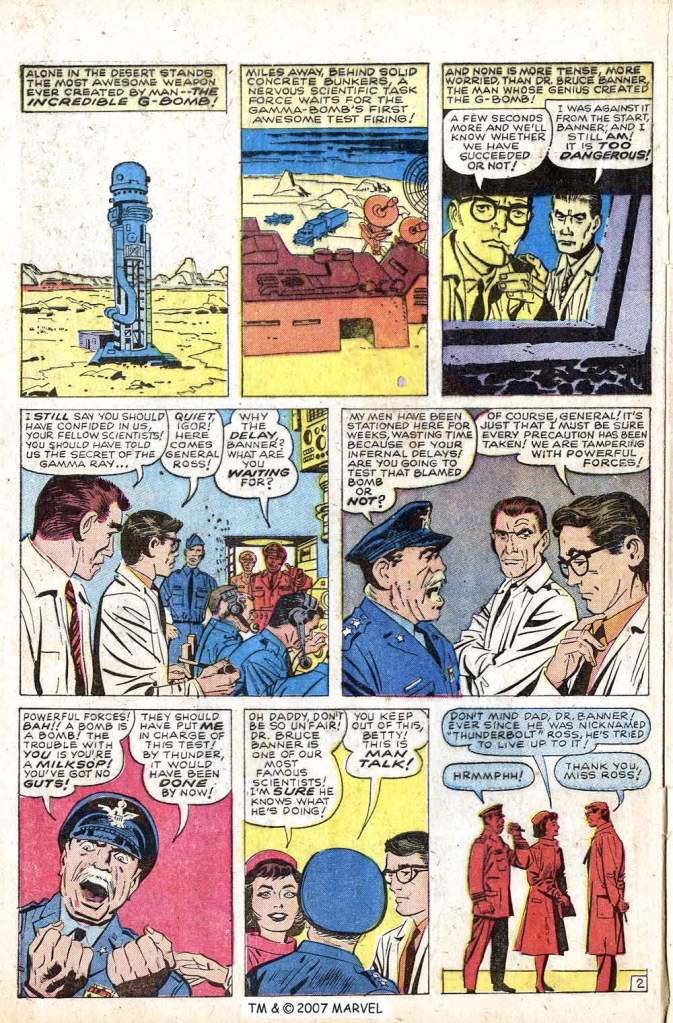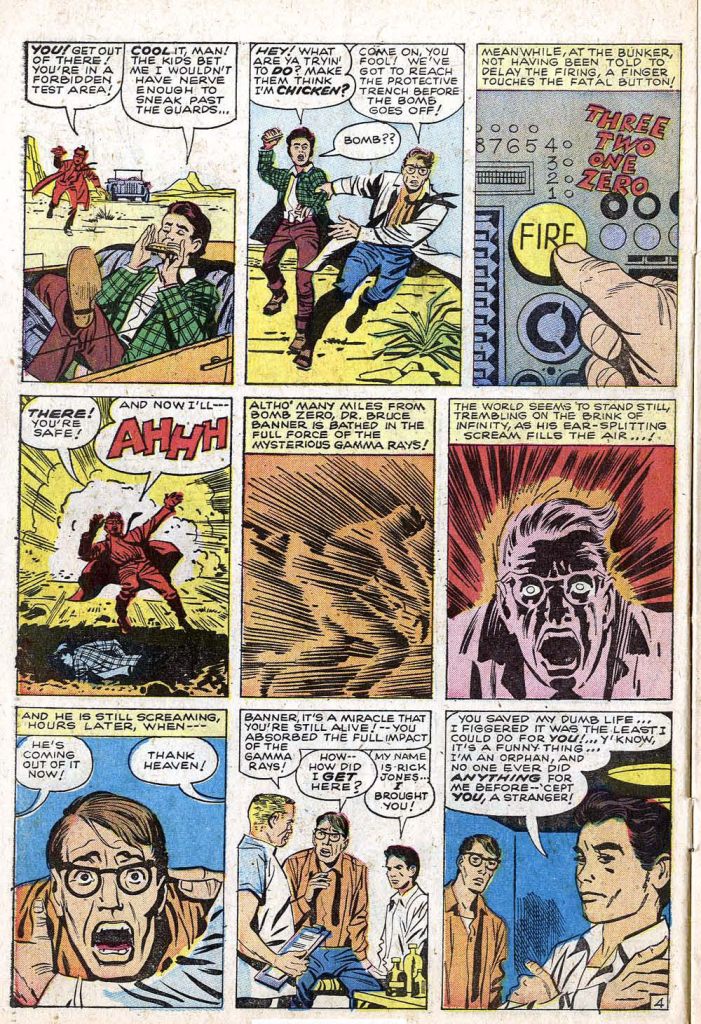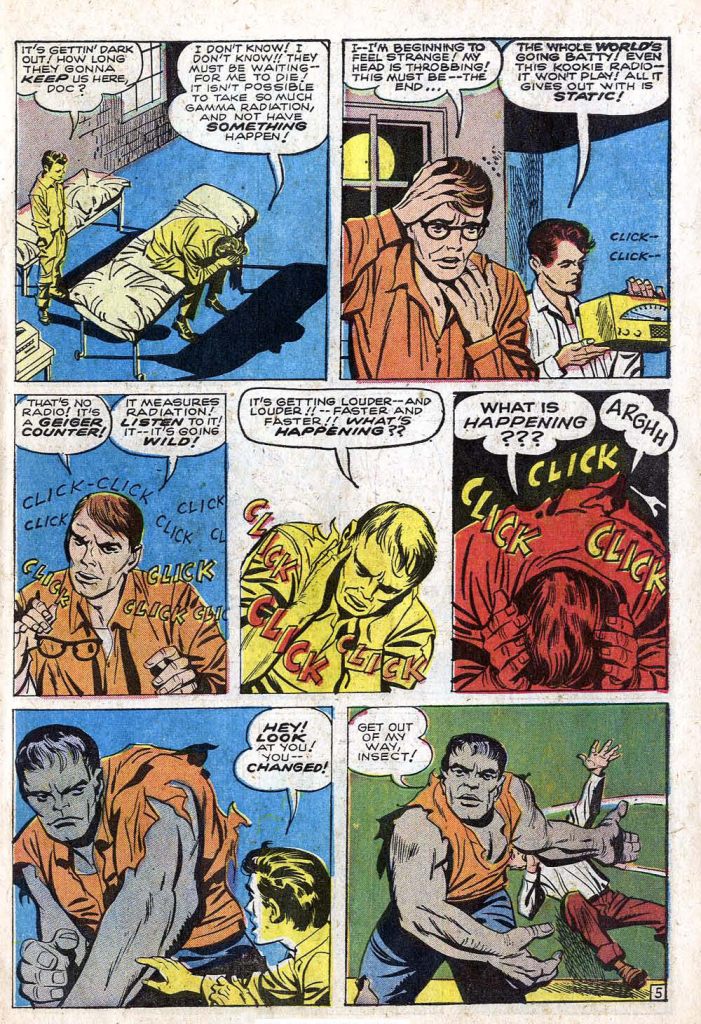
In the latest issue of the fantastic magazine THE JACK KIRBY COLLECTOR published by TwoMorrows Publications (and available at this link: )
…writer and comics historian Will Murray contributes a piece taking a closer look at INCREDIBLE HULK #1. Murray’s contention is that the character of the Hulk originally had a different name, which was re-lettered in the final book, and he lays out a compelling case for his thoughts within that piece. But thinking about some of the evidence that he posed got me coming up with some different (though not wholly-incompatible) conclusions about the provenance of this first issue. I’m still working out some of this stuff–and there are certainly places where I may be off the beam. Nevertheless, I’m going to share my thoughts with the collective fandom here, and see if it all takes us anywhere.






Part of what drives Murray’s conclusions is the often-overlooked fact that letterer Ray Holloway letters most of the first two chapters of INCREDIBLE HULK #1. Only the splash page and the Chapter 2 splash were lettered by Art Simek, who also letters the remainder of the issue. Murray says that he suspects that this indicates that the opening section may have been a “pilot” piece worked up by Jack Kirby to sell Stan Lee and more importantly Martin Goodman on the concept of the series. And that may be so, but it doesn’t ring true to me. In no other case that we’re aware of had Kirby drawn up what amounts to almost a dozen pages of a prospective Marvel series on spec. No, what those opening pages lettered by another hand suggest to me is that they had been created separate from the remainder of the issue, in the mode of FANTASTIC FOUR #1. I think what this suggests is that, rather than having been conceived as a series that would launch in its own title, INCREDIBLE HULK was started with the intention of it being a shorter feature in one of the assorted mystery/suspense titles–and it may have been started as a one-off with room for a sequel, much as the first Thor story was.
With that idea in mind, I look at the opening splash page to INCREDIBLE HULK #1, and I feel as though there’s no way that wasn’t initially produced as Jack Kirby’s design sheet for the title character. As in the case of Daredevil years later, it wound up being repurposed as the first page of the story. Murray points to the odd way that the name Hulk is on a line by itself in that introductory caption as an example of a lettering change. It’s difficult to say looking only at the printed book (the printing on the copy I’m looking at isn’t all that great to begin with) but it’s certainly possible. Murray’s theory is that the original name for the creature was longer, and he suggests, based on other contextual clues, that it may have been MAN-MONSTER. Regardless, that caption is the only bit of lettering on this page that was done by Holloway; the logo and the title lettering is by Art Simek.
THere’s evidence of what may have been some minor rewriting and relettering on Page 2, mainly in the middle tier. In Panel 4, the bottom portion of General Ross’s balloon looks to have been altered, and his name was shoehorned into Banner’s balloon right before that. There’s some strangeness in Panel 5 as well, both with the end of Ross’s balloon (that OR NOT appears to have been added in after the fact) and the last sentence of banner’s balloon there. On the other hand, this could simply be evidence of Holloway’s od lettering style. There are a few balloons on Page 3, for example, that are strangely shaped and look even a little bit crude. It’s also possible that he was working quickly on these pages for whatever reason. On Page 4, Murray makes a conjecture about the balloon in Panel 8 where Rick Jones identifies himself. To my eye, this balloon was added in after the fact by somebody doing production work, and likely because Lee realized that he hadn’t named Rick Jones in the early part of the story. That balloon is crammed into that tiny space haphazardly, and to my eye it looks like the work of Sol Brodsky, who wasn’t a full-time lettterer, but who would occasionally be called upon to make corrections such as this one.





The first chapter of the story takes up 6 pages. This wasn’t unheard of, but it was more typical of the monster books of the period to divide up their contents into units of 5-5-3 if it was a 13 page story. it could be that the addition of the design sheet as the opening splash page inflated that count. By that same token, the title page to Chapter 2 was entirely lettered by Art Simek–not only the chapter title, but the caption and the balloon as well. This implies to me that it might have been added in after the fact. You could certainly jump directly from Page 6 to Page 8 without any problem.
Much of Murray’s evidence for the Hulk having a name-change comes from this chapter, where the character is first christened by a soldier and then the name stick, being repeated several times. he points out a couple of places where there may be evidence of relettering (and what seems to have been a longer word originally that is being compensated for.) But what makes this a bit more suspect to my mind is that it doesn’t hold in all cases. Certainly, on Page 8 in Panel 1, I can see where it’s possible that Hulk in those two instances had been something else previously. But the instance of Hulk in the second balloon in Panel 2 doesn’t really allow for the same. I’m not saying that Murray is wrong here, merely pointing out an inconsistency that doesn’t entirely track. The same is true of Panel 3 (where a change could have happened) and Panel 5 (where the same change doesn’t appear possible.)
Now, if this had been put together initially as a stand-alone story, there are two possibilities once we get to the end of Page 11 here. The first is that the story wudl have concluded with Banner’s transformation as the sun comes up, with the final panel here replacing perhaps a blurb asking readers to write in if they want to read further Hulk adventures. That said, that does feel a bit abrupt to me. The other possibility is that there was originally another page after this that was discarded, which wrapped up the story as a stand-alone piece. This also seems unlikely given that no evidence of such a page has ever turned up. But if it was just the final panel that was replaced, why is what sees print here lettered by Holloway? It’s a bit of a mystery.



There’s an argument to be made that the first Hulk story would have ended on Page 14. That’s a very nice little wrap-up for a one-off, and it brings Betty Ross from the opening pages back into the narrative, which tracks. The only problem is that these three pages were lettered by Art Simek, as was the rest of the issue. I suppose it’s possible that Holloway had begun working on the story at some point and then was told to stop once Lee and Goodman had made the decision to launch the Hulk as a stand-alone comic rather than as a lead feature in STRANGE TALES or TALES OF SUSPENSE or whatever, as would become standard operating procedure with the new super hero characters from here on out.


It is telling that the segue to the Gargoyle being the mastermind behind Banner’s Red spy assistant Igor doesn’t get revealed until chapter four of the final issue. The remaining 10 pages feel like separate adventure that’s been bolted onto the origin story. I think it’s likely that Igor didn’t have any particular superior, he was simply a spy doing a spy’s work, and got caught by the Hulk and roughed up for his trouble. I believe the back ten pages of this issue weren’t part of the original plan, and were only added on when the Hulk became a full -length book. (It’s even possible that they were intended as a separate story entirely. If you drop the Part 4 splash page, Igor isn’t addressed again. The gargoyle could simply have been called upon in response to either the Hulk or Bruce Banner’s bomb tests.) I don’t know what might have motivated martin Goodman to go in this direction. It may simply have been the strong interest in monsters in the popular culture then–remember, Kirby had proposed the Hulk as a sort of continuing character version of an earlier monster story he and Lee had done.
Unfortunately, none of the original artwork for INCREDIBLE HULK #1 has turned up in the years since. As with fANTASTIC FOUR #1, studying the original boards would no doubt have given us some greater insight into what may have been behind all of these mysteries. Without it, we may never be able to tell for certain. (Not that any of this is especially critical–but it is interesting, at least from my perspective.)

Just by way of example, here’s an image of the final page of the first Thor story from JOURNEY INTO MYSTERY #83 with the original blurb in the final panel from when it was intended as a one-off story with the possibility of a sequel. It isn’t difficult to imagine a similar such blurb taking the place of the final panel on Page 11 of INCREDIBLE HULK #1.

Many years ago, I read an analysis of I.Hulk #1 that had much of the same conclusion–that a model sheet became the first page, that what was to have been a new ongoing strip was expanded into the first issue. I don’t think it was by Will Murray. I think it was either proposed or quoted by Mark Evanier.
LikeLike
Interesting, though I have absolutely nothing helpful to contribute.
LikeLiked by 1 person
Great insights; you have logically laid out the proposition that this was intended as a “try-out” feature converted at some point in the process into a feature-length story.
LikeLike
Hmm. Would it be possible for you to get the stats, as you did with FF#1?
In the top two panels of page 8, “monster” is too long to fit in place of “hulk” anywhere. “Don’t let the monster get his hands on you!” sounds natural, but the spacing doesn’t work. Same with “Could the monster have –??”. The regular word “thing” would fit, if it was written not remembering at the moment there already was a “Thing” character. But that feels like a reach.
If the character was pitched in reference to the “Midnight Monster”, I can see “Man-Monster” being the name used in the first few discussions of the character. “Half-man, half-monster, the mighty Man-Monster …” makes a lot of sense as a initial proposal (great alliteration). But by the time the story is being lettered, that seems quite far along the process.
I wonder if the first Hulk issue initially was intended to have a back-up standard monster story too in the last ten pages, or two short twist stories of five pages. But Goodman then decided to go all-in with the character, leading to having the Gargoyle material added. This isn’t quite the same has having the Hulk be an ongoing feature in a “TALES” book. Rather, he wanted to launch the superhero characters in their own books, but maybe at first to hedge a little with back-up stories (this is my speculation about the grafted-looking last section of FF#1).
Did anyone ever interview Martin Goodman about Marvel history? A quick search doesn’t find anything.
LikeLiked by 1 person
I believe that GCD attributed the lettering to Holloway, but it doesn’t look like his work to me (compare Journey into Mystery 89, one of his first credits). It reminds me of Herb Cooper, with the wide M’s and W’s, but I’m not certain. (Cooper worked in production during the Atlas era and had a few lettering credits for Marvel from 1968-72–Daredevil #50 among them, in late 1968.)
LikeLike
any idea who the inker was? Ayers?
LikeLike
Paul Reinman.
LikeLike
Another intriguing lettering detail: the opening panel of page 8 is Simek’s work. I suspect this panel was substitute for a different (perhaps too violent?) one, very late in the process. The art includes a footstool (left of the table) that doesn’t appear anywhere else in the story, suggesting to me that Kirby didn’t have the original art in front of him when the change was made.
Pages 1-14 seem like a self-contained tale to me as well. The fact that Simek lettered Chapter 3 but not Chapter 1 or 2 (but for the display lettering) was not unusual around 1962. I’ve seen other stories from this period where different chapters were done by different letterers (likely due to deadline pressures).
LikeLike
Great article. I would point out that most if not all the 13 page monster stories were in two chapters, with splash pages on page one and page seven. I can’t think of any examples of when the story was broken into 5-5-3 sections, like you mention.
LikeLike